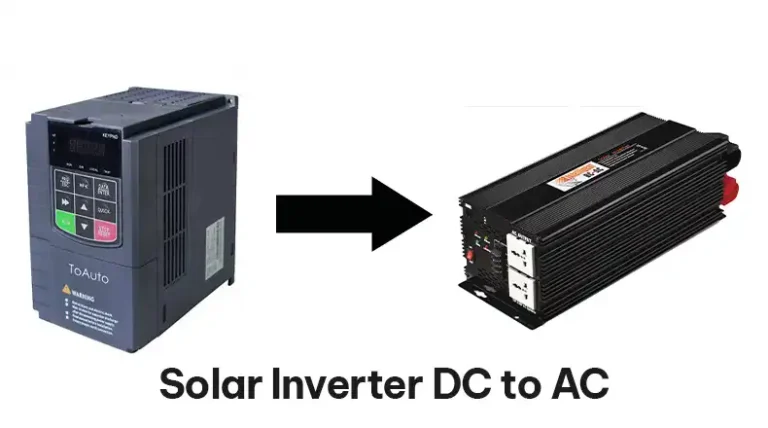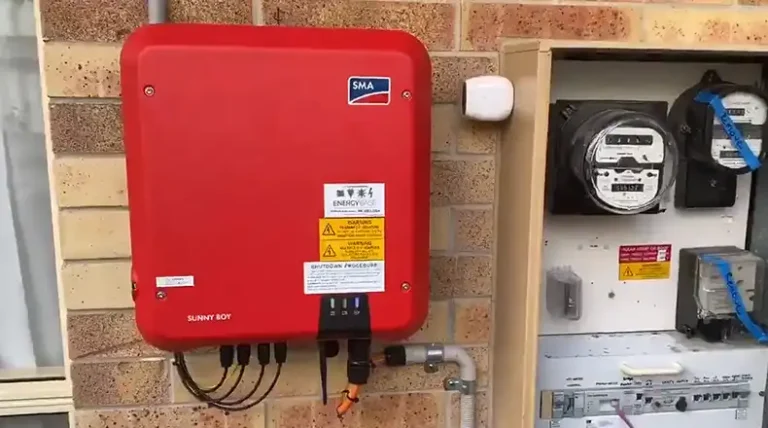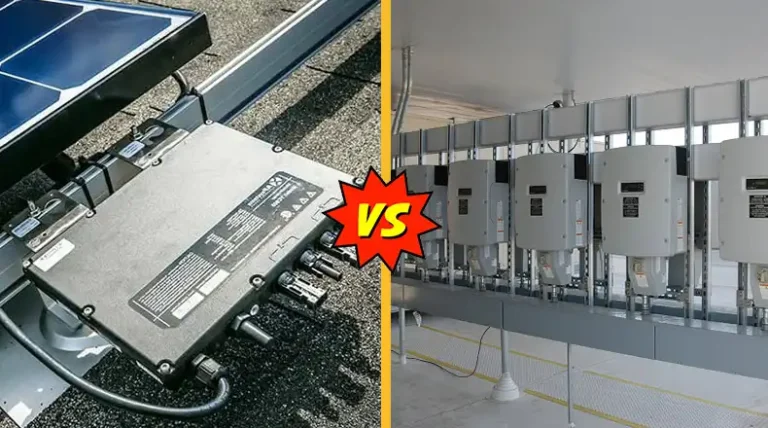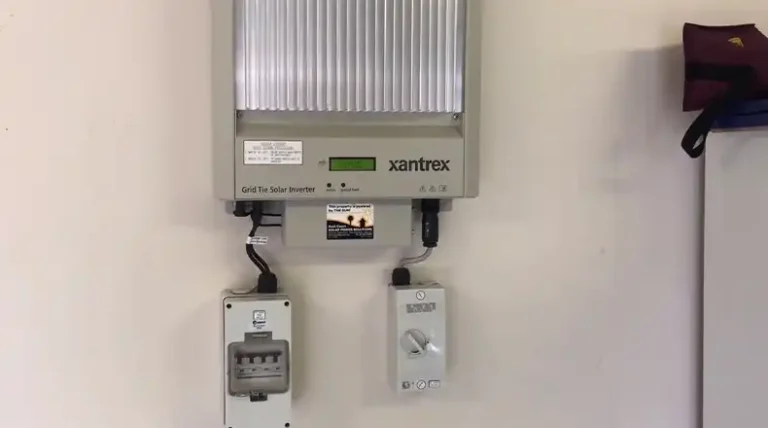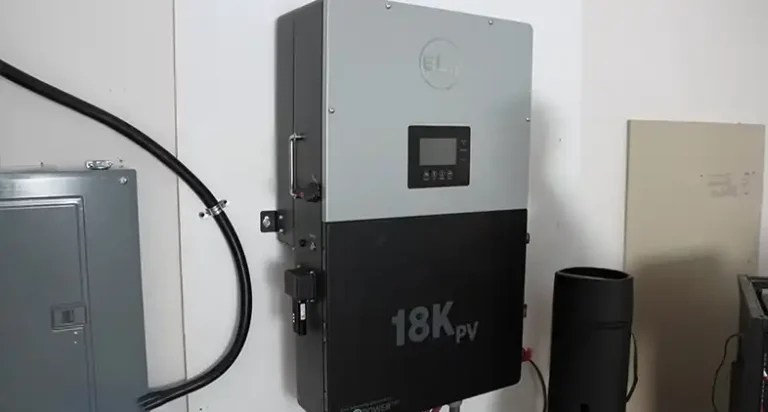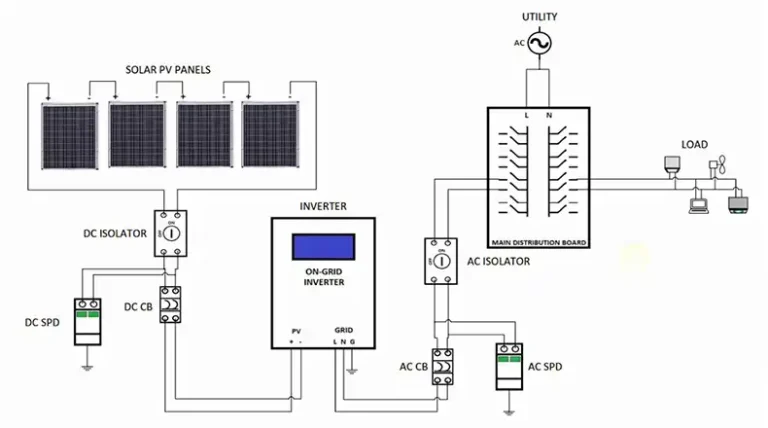Solar PV Inverter Sizing | Complete Guide
Solar PV inverters play a crucial role in solar power systems by converting the Direct Current (DC) generated by the solar panels into Alternating Current (AC) that can be used to power household appliances, fed into the grid, or stored in batteries. Proper inverter sizing is vital for ensuring optimal system performance, efficiency, and longevity.
An undersized inverter can lead to clipping losses, where the excess DC power generated by the solar panels is wasted due to the inverter’s inability to handle the full output. On the other hand, an oversized inverter not only increases the initial cost but can also damage the inverter itself. Therefore, It’s essential to strike the right balance when sizing your solar PV inverter.
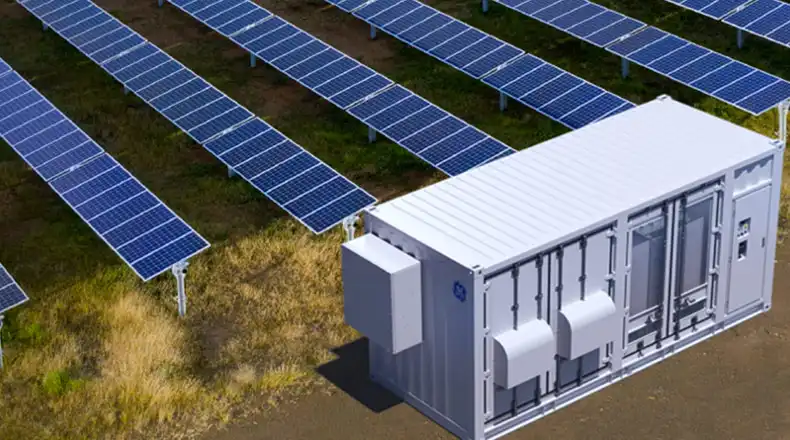
What to Consider Before Sizing Your Solar Inverter?
Before selecting an appropriate inverter size, there are several key factors to consider, including the total system size (DC wattage of all solar panels), expected energy consumption (daily and peak usage in kW), future expansion plans, local climate, and solar irradiance levels.
System Size (Total DC Wattage of Solar Panels)
The first step in inverter sizing is to determine the total DC wattage of all the solar panels in your system. This information is typically provided by the manufacturer and can be found on the panel’s datasheet.
Expected Energy Consumption
Consider your household’s daily and peak energy consumption to ensure that the inverter can handle the load. This information can be obtained by analyzing your past electricity bills or conducting an energy audit.
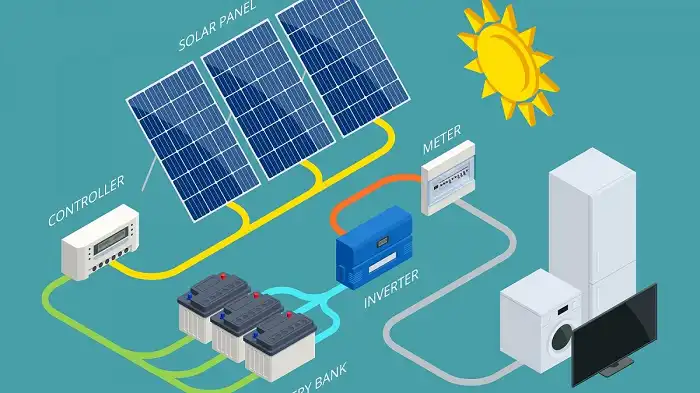
Future Expansion Plans
If you plan to expand your solar system in the future by adding more panels, It’s wise to consider an inverter that can accommodate this growth. This approach can save you from having to replace the inverter when expanding your system.
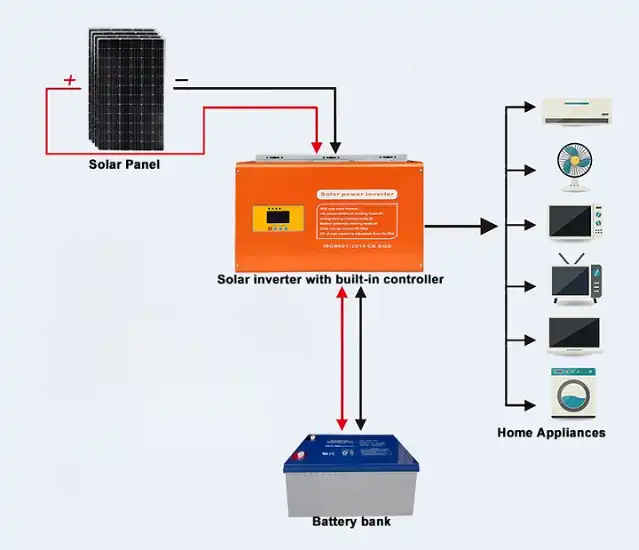
Local Climate and Solar Irradiance Levels
The local climate and solar irradiance levels can impact the amount of power generated by your solar panels. Areas with higher irradiance levels may require larger inverters for the same size array due to increased power production.
Solar PV Inverter Sizing Calculations
The process of inverter sizing involves understanding the relationship between DC (Direct Current) from the solar panels and AC (Alternating Current) required for powering appliances. The Inverter Sizing Formula is –
AC Inverter Capacity (kW) = DC Input Power (kW) / Inverter Efficiency (%)
However, several derating factors can affect the inverter’s output, including ambient temperature, altitude, soiling, and shading.
Derating Factors Affecting Inverter Output
Ambient Temperature
Higher ambient temperatures can reduce the inverter’s output capacity. Here’s a table with typical derating values for different temperature ranges –
| Ambient Temperature Range | Derating Factor |
| -20°C to 25°C | 1.0 |
| 25°C to 40°C | 0.91 |
| 40°C to 50°C | 0.84 |
| 50°C to 60°C | 0.76 |
Altitude
Higher altitudes can also impact the inverter’s output. Here’s a table with typical derating values for different altitude ranges –
| Altitude Range (meters) | Derating Factor |
| 0 – 1000 | 1.0 |
| 1000 – 2000 | 0.98 |
| 2000 – 3000 | 0.96 |
| 3000 – 4000 | 0.93 |
Soiling and Shading
Soiling and shading can significantly reduce the amount of sunlight reaching the solar panels, thereby affecting the inverter’s input power. Different shading patterns, such as partial shading, full shading, or string shading, can significantly impact the inverter sizing requirements. It’s crucial to conduct a shading analysis using tools like the Solar Pathfinder or PVWatts to accurately account for these factors in your inverter sizing calculations.
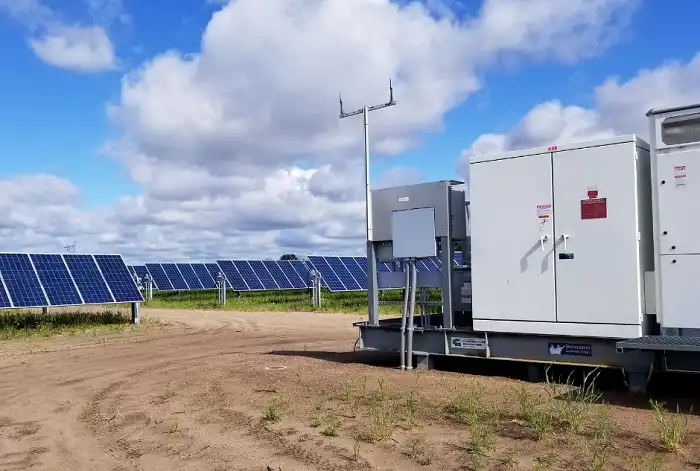
Derating Calculation Examples
Suppose you have a 10 kW solar array installed in a location with an ambient temperature of 35°C and an altitude of 1500 meters. Assuming an inverter efficiency of 95% and a derating factor of 0.9 (based on temperature and altitude), the required inverter capacity would be –
AC Inverter Capacity = (10 kW / 0.9) / 0.95 = 11.76 kW
Without considering the derating factors, you might have undersized the inverter, leading to potential clipping losses and reduced system performance.
Additional Sizing and Calculation Terms of Solar Inverter
Beyond the basic sizing calculations, there are several important terms and concepts to understand for proper inverter sizing and system design.
DC-to-AC Ratio
The DC-to-AC ratio, also known as the Array-to-Inverter Ratio, is the ratio of the installed DC capacity (solar panel wattage) to the inverter’s AC output capacity. A typical DC-to-AC ratio ranges from 1.1 to 1.3, with 1.2 being a common value for slight oversizing.
Startup Surge Current (Inrush Current)
Some appliances, such as motors and compressors, can draw a high initial current (known as the startup surge current or inrush current) when starting up. It’s crucial to ensure that your inverter is compatible with these surge currents to prevent tripping or damage. Here’s a table with typical surge current values for common appliances –
| Appliance | Startup Surge Current |
| Air Conditioner | 6-10x running current |
| Refrigerator | 3-6x running current |
| Washing Machine | 5-8x running current |
| Microwave Oven | 2-3x running current |
Continuous vs. Peak Power Output
It’s essential to differentiate between the inverter’s continuous power rating and its peak power output. The continuous rating refers to the sustained power output the inverter can handle, while the peak rating represents the short-term power surge capability.
Clipping Losses
Clipping losses occur when the inverter can’t handle the peak power output from the solar panels, resulting in wasted energy. Proper inverter sizing is crucial to minimize these losses and ensure optimal system performance. In the following section, we’ll discuss clipping losses in detail.
Inverter Clipping: In-Depth Analysis
Inverter clipping refers to the situation where the inverter can’t handle the maximum DC power output from the solar panels, resulting in wasted energy. This occurs when the Array-to-AC Ratio (DC-to-AC Ratio) is too high.
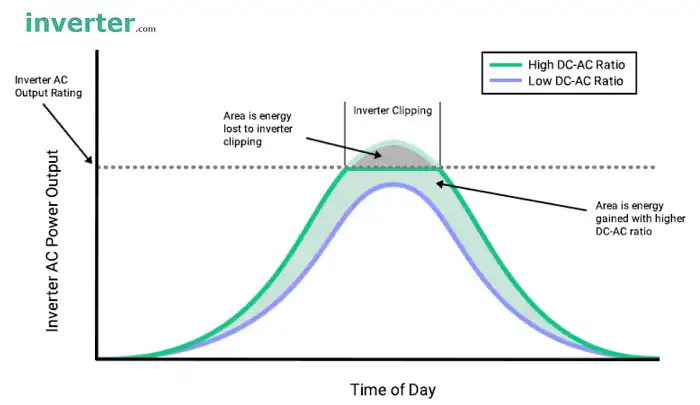
Impact of Array-to-AC Ratio on Clipping
A higher Array-to-AC Ratio can reduce the likelihood of clipping but also increase the overall system cost. It’s essential to strike a balance between minimizing clipping losses and maintaining a reasonable investment.
Strategies to Mitigate Clipping
Several strategies can be employed to mitigate inverter clipping –
- Oversizing the Solar Array: By slightly oversizing the solar array (e.g., using a DC-to-AC ratio of 1.2), you can increase the overall energy production while minimizing the impact of clipping. However, It’s crucial to conduct a cost-benefit analysis to ensure that the additional energy production justifies the increased investment.
- Using Multiple Inverters: Instead of a single large inverter, you can consider using multiple smaller inverters. This approach can help distribute the load and reduce the risk of clipping, but it also increases system complexity and installation costs.
- Optimizing Panel Layout: By optimizing the layout of the solar panels and minimizing shading, you can reduce the likelihood of clipping. This strategy may involve repositioning panels, trimming trees, or adjusting the panel orientation.
Comparison of Inverter Clipping Losses
To better understand the impact of the Array-to-AC Ratio on clipping losses, let’s consider a case study. The following table compares the clipping losses for a 10 kW solar array with different Array-to-AC ratios –
| Array-to-AC Ratio | Inverter Size | Clipping Losses (Annual) |
| 1.1 | 9.1 kW | 2.5% |
| 1.2 | 8.3 kW | 1.2% |
| 1.3 | 7.7 kW | 0.4% |
As shown in the table, a higher Array-to-AC ratio results in lower clipping losses but requires a smaller inverter size. For instance, with a 1.3 Array-to-AC ratio, the clipping losses are only 0.4%, but the inverter size required is 7.7 kW. In contrast, a lower 1.1 Array-to-AC ratio has higher clipping losses of 2.5% but requires a larger 9.1 kW inverter.
One approach to mitigate clipping losses while maintaining a reasonable system cost is to use a moderate Array-to-AC ratio, such as 1.2. In the case study, an Array-to-AC ratio of 1.2 results in clipping losses of 1.2% while requiring an 8.3 kW inverter, which may be a more cost-effective solution compared to the 1.3 ratio.
Types of Solar Inverters and Sizing Considerations
There are several types of solar inverters available in the market, each with its own unique characteristics and sizing considerations. The most common types include string inverters, microinverters, and power optimizers.
String Inverters
String inverters are the most commonly used type of inverter in residential and commercial solar installations. Sizing for string inverters is based on the total DC input of all connected solar panels, taking into account the derating factors discussed earlier.
One of the limitations of string inverters is that they are susceptible to string mismatch and partial shading issues. If one panel in the string is underperforming or shaded, it can negatively impact the overall output of the entire string.
String inverters are suitable for systems with consistent panel orientation and minimal shading concerns.
Microinverters
Microinverters are installed at the individual panel level, with one microinverter dedicated to each solar panel. This design allows for maximum power production from each panel, as It’s not affected by string mismatch or partial shading issues.
While microinverters have a higher upfront cost compared to string inverters, they offer better shade tolerance and granular monitoring capabilities. Sizing for microinverters is based on the individual panel wattage, and clipping can still occur if the microinverter can’t handle the panel’s maximum output.
Microinverters are well-suited for systems with complex roof shapes, shading concerns, or future expansion plans.
Power Optimizers
Power optimizers, also known as DC-DC converters, are installed at the panel level, similar to microinverters. They optimize the DC power output from each panel before sending it to a central string inverter.
Power optimizers can mitigate the effects of string mismatch and improve efficiency in systems with shading or panel mismatch issues. They also offer granular monitoring capabilities.
Sizing for systems with power optimizers is based on the central inverter’s capacity and the derating factors associated with the inverter. While power optimizers can reduce clipping losses, they may not eliminate them depending on the system design.
Power optimizers are suitable for systems with potential shading or panel mismatch concerns.
Note: When selecting an inverter type, It’s essential to consider the derating factors associated with each type. For example, microinverters and power optimizers may have different derating factors compared to string inverters due to their unique designs and operating characteristics.
Bottom Line
Proper inverter sizing is crucial for ensuring optimal performance, efficiency, and longevity of your solar power system. By considering factors such as system size, energy consumption, future expansion plans, local climate, and solar irradiance levels, you can select the appropriate inverter size for your installation.
Understanding derating factors, clipping losses, and the impact of the Array-to-AC ratio is essential for accurate inverter sizing calculations. Additionally, consulting with a solar professional can provide valuable expertise, site assessments, and cost-benefit analyses to make informed decisions
Frequently Asked Questions
Can I use a single inverter for multiple solar arrays with different orientations?
While It’s possible to use a single inverter for multiple solar arrays with different orientations, it may not be the most efficient approach. Each array will have different peak production times, and a single inverter may struggle to handle the combined output, leading to clipping losses. It’s generally recommended to use separate inverters or power optimizers for arrays with significantly different orientations.
How often should I replace my solar inverter?
The lifespan of a solar inverter can vary depending on the manufacturer, operating conditions, and maintenance practices. Most residential inverters have a typical lifespan of 10-15 years, while commercial and utility-scale inverters may last up to 20 years or more. Regular monitoring and maintenance can help extend the inverter’s lifespan, but replacement may be necessary after a certain period to maintain optimal system performance.
Can I use a larger inverter than recommended for my solar array?
While It’s generally not recommended to use an inverter that is significantly larger than the solar array’s capacity, a slight oversizing (e.g., using a DC-to-AC ratio of 1.2) can be beneficial. This approach can help reduce clipping losses and allow for future expansion of the solar array. However, It’s essential to strike a balance and avoid excessive oversizing, as it can lead to increased costs and potential inverter damage.

